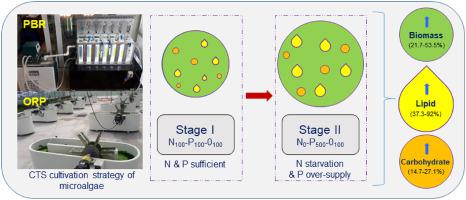Journal of Environmental Management ( IF 8.7 ) Pub Date : 2020-07-08 , DOI: 10.1016/j.jenvman.2020.111041 Manoranjan Nayak 1 , William I Suh 2 , Jun Muk Cho 3 , Hee Su Kim 4 , Bongsoo Lee 5 , Yong Keun Chang 3

|
Lipid production in microalgae under nitrogen (N) starved condition can be enhanced by excess phosphorus (P) supply in the second stage of two-stage cultivation strategy. However, implementing two-stage cultivation is difficult in large-scale cultivation system as it requires high energy of transferring large algal biomass from first stage to second stage. To address this problem, we have optimized a continuous two-stage (CTS) cultivation strategy using Chlorella sp. HS2, where nitrogen in the growth environment is depleted naturally via consumption. To enhance both biomass and lipid productivity this strategy explored supplementation of additional P from 50% to 2500% of the initial concentration at the start of N-limited second stage of growth. The results of the optimization study in photobioreactor (PBR) showed that supplementing 500% of initial P and 100% of initial other nutrients (O) (N0–P500–O100) on 5th day showed the maximum biomass productivity of 774.4 mg L−1 d−1. It was observed that Chlorella sp. HS2 grown in PBR yielded higher biomass (3.8 times), lipid (6.1 times) and carbohydrate (5.5 times) productivity in comparison to the open raceway ponds (ORP) study, under optimum nutrient and carbon supply condition. The maximum lipid (289.6 mg L−1 d−1) and carbohydrate (219.2 mg L−1 d−1) productivities were obtained in TPBR-3, which were 1.9 and 1.3 times higher than that of TPBR-2 (+ve control) and 9.6 and 3.7 times higher than that of TPBR-1 (-ve control), respectively. Fatty acid mainly composed of C16/C18 (84.5%–85.7%), which makes the microalgal oil suitable for biofuel production. This study concluded that feeding excess amount of P is an effective and scalable strategy to improve the biomass and lipid productivity of CTS cultivation.
中文翻译:

小球藻连续两阶段培养中磷补充策略的战略实施。HS2:生物燃料应用评估。
在两阶段培养策略的第二阶段,通过过量供应磷(P)可以提高氮(N)饥饿条件下微藻中的脂质生产。然而,在大规模栽培系统中,实施两阶段栽培是困难的,因为这需要大量能量将大量藻类生物质从第一阶段转移到第二阶段。为了解决这个问题,我们优化了使用小球藻的连续两阶段(CTS)培养策略sp。HS2,生长环境中的氮通过消耗自然耗尽。为了提高生物量和脂质生产率,该策略探索了在氮限制的第二阶段生长开始时,从初始浓度的50%补充到2500%的补充磷。在光生物反应器(PBR)中进行的优化研究结果表明,在第5天补充500%的初始P和100%的其他初始养分(O)(N 0 –P 500 –O 100)显示最大生物量生产力为774.4 mg L -1 d -1。据观察,小球藻sp。与开放式水塘(ORP)研究相比,在最佳养分和碳供应条件下,PBR中生长的HS2产生了更高的生物量(3.8倍),脂质(6.1倍)和碳水化合物(5.5倍)生产率。TPBR-3的最大脂质(289.6 mg L -1 d -1)和碳水化合物(219.2 mg L -1 d -1)的生产率分别是TPBR-2的1.9和1.3倍(+ ve control ),分别是TPBR-1(-ve control)的9.6和3.7倍。主要由C 16 / C 18组成的脂肪酸(84.5%–85.7%),这使得微藻油适合用于生物燃料生产。这项研究得出的结论是,饲喂过量的P是提高CTS培养生物量和脂质生产力的有效且可扩展的策略。



























 京公网安备 11010802027423号
京公网安备 11010802027423号